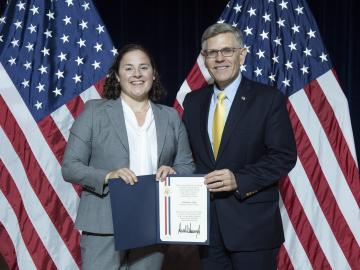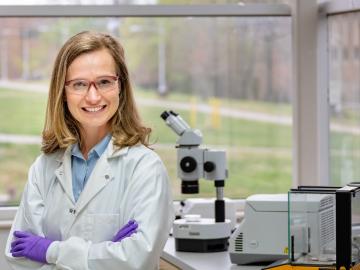
Filter News
Area of Research
- (-) Biology and Environment (4)
- (-) Neutron Science (23)
- (-) Supercomputing (31)
- Advanced Manufacturing (6)
- Biological Systems (1)
- Building Technologies (1)
- Clean Energy (60)
- Climate and Environmental Systems (2)
- Computational Engineering (1)
- Computer Science (8)
- Fusion Energy (6)
- Materials (55)
- National Security (5)
- Nuclear Science and Technology (11)
- Quantum information Science (3)
- Transportation Systems (1)
News Topics
- 3-D Printing/Advanced Manufacturing (1)
- Advanced Reactors (1)
- Artificial Intelligence (6)
- Big Data (4)
- Bioenergy (3)
- Biomedical (4)
- Clean Water (1)
- Computer Science (25)
- Cybersecurity (2)
- Energy Storage (4)
- Environment (7)
- Exascale Computing (2)
- Frontier (2)
- Grid (1)
- Machine Learning (1)
- Materials Science (3)
- Microscopy (1)
- Nanotechnology (1)
- Neutron Science (18)
- Nuclear Energy (3)
- Physics (3)
- Quantum Science (5)
- Security (1)
- Space Exploration (2)
- Summit (9)
- Sustainable Energy (2)
- Transportation (1)
Media Contacts

Artificial intelligence (AI) techniques have the potential to support medical decision-making, from diagnosing diseases to prescribing treatments. But to prioritize patient safety, researchers and practitioners must first ensure such methods are accurate.

Materials scientists, electrical engineers, computer scientists, and other members of the neuromorphic computing community from industry, academia, and government agencies gathered in downtown Knoxville July 23–25 to talk about what comes next in

Using the Titan supercomputer at Oak Ridge National Laboratory, a team of astrophysicists created a set of galactic wind simulations of the highest resolution ever performed. The simulations will allow researchers to gather and interpret more accurate, detailed data that elucidates how galactic winds affect the formation and evolution of galaxies.

Collaborators at the Department of Energy’s Oak Ridge National Laboratory and U.S. universities used neutron scattering and other advanced characterization techniques to study how a prominent catalyst enables the “water-gas shift” reaction to purify and generate hydrogen at industrial scale.

Two researchers from the Department of Energy’s Oak Ridge National Laboratory have received a 2019 Presidential Early Career Award for Scientists and Engineers, or PECASE.
A team of scientists led by Oak Ridge National Laboratory have discovered the specific gene that controls an important symbiotic relationship between plants and soil fungi, and successfully facilitated the symbiosis in a plant that

Researchers have pioneered a new technique using pressure to manipulate magnetism in thin film materials used to enhance performance in electronic devices.

Scientists have discovered a way to alter heat transport in thermoelectric materials, a finding that may ultimately improve energy efficiency as the materials

An ORNL-led team's observation of certain crystalline ice phases challenges accepted theories about super-cooled water and non-crystalline ice. Their findings, reported in the journal Nature, will also lead to better understanding of ice and its various phases found on other planets, moons and elsewhere in space.

Amber McBride is using her expertise in nanotechnology, drug delivery, and disease models to research fundamental challenges in human health in the ORNL Biosciences Division.


